Excerpts from Jim Conrad's
Naturalist Newsletter
from the October 12, 2018 Newsletter with notes from a camping trip earlier the month into Chiapas, MÉXICO
TEAK PLANTATIONS IN SOUTHERN MEXICO
On October 3rd as a van carried me from El Ciebo, Tabasco to Palenque, Chiapas, in southern Mexico, fair-sized tree plantations appeared along the road in many places, and I couldn't identify what was being grown. Later that day as I hiked the several-kilometer-long bike-path/walkway between the town of Palenque and Palenque ruins (N 17.489°, W 92.034°, elev. ~60m, ~200ft), the same tree species turned up spottily planted along the route. Below, you can see the tree's distinctive large, rounded leaves and big, diffuse, panicle-type flowering heads, or inflorescences, bearing many tiny flowers:
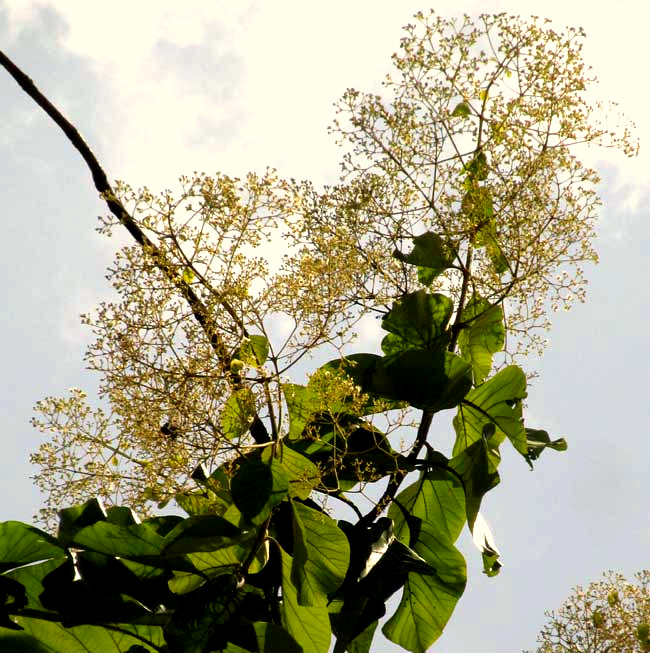
On the stems, leaves arose opposite one another, as shown below:
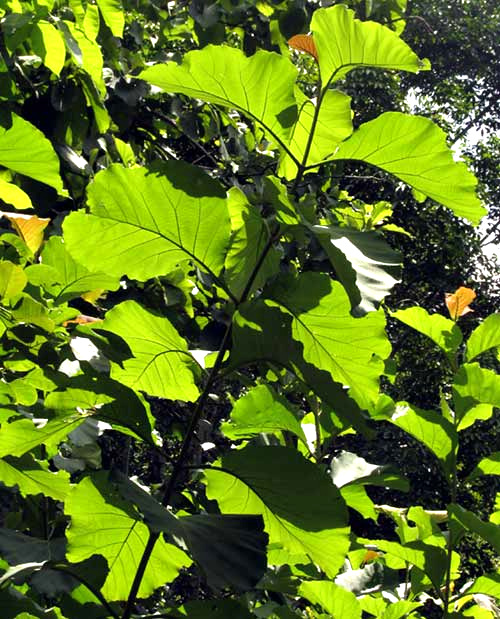
All these details were noted high in the trees, well beyond my reach. However, the telephoto lens revealed that the stems were four-angled, or squared, with furrows along at least some of the stem sides, seen below:
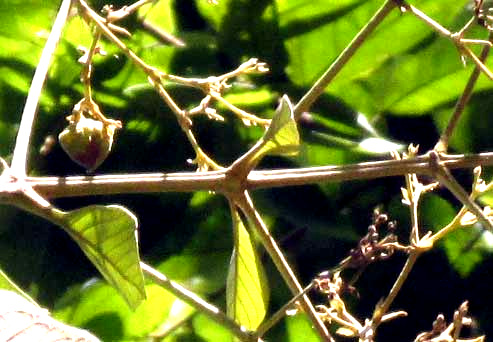
Usually plant identification is most dependent on the appearance of flowers and fruits. This tree's inflorescences were doing something interesting, shown below:
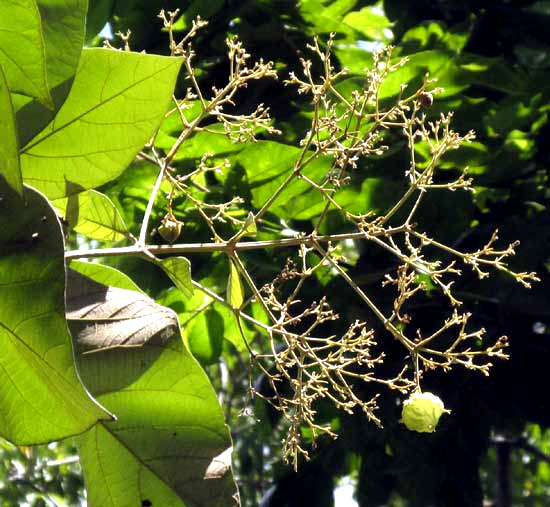
In all the inflorescences, the vast majority of flowers had fallen off without producing fruits. In the picture, a single spherical fruiting structure is shown, but in other inflorescences sometimes two, three or more were observed. I call them fruiting structures because the yellowish-green, spherical item in the above picture seems to be doing something surprising for a fruit. Once again the telephoto lens helped out, with the image seen below:

The spherical item seems to be a kind of bladder so thin that light filters through it. Note the bladder's opening at a point opposite its attachment to the main inflorescence axis. It took awhile to find one of these bladdery objects on the ground, apparently still immature, maybe knocked there by a squirrel or the wind. Opening up the bladder of a fallen one revealed the hard, spherical, very hairy immature fruit shown below:
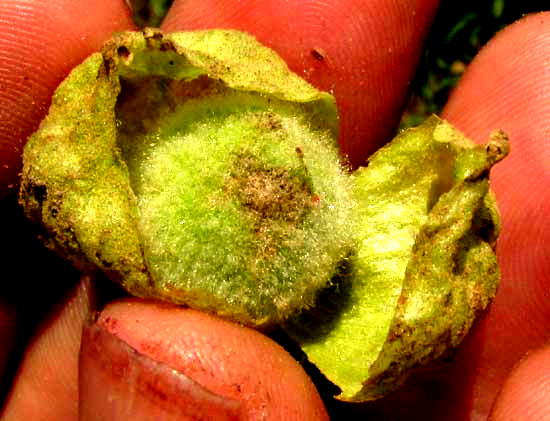
Cutting across the fruit revealed a very hard seed, and showed how thick and dense the furry covering was, seen below:
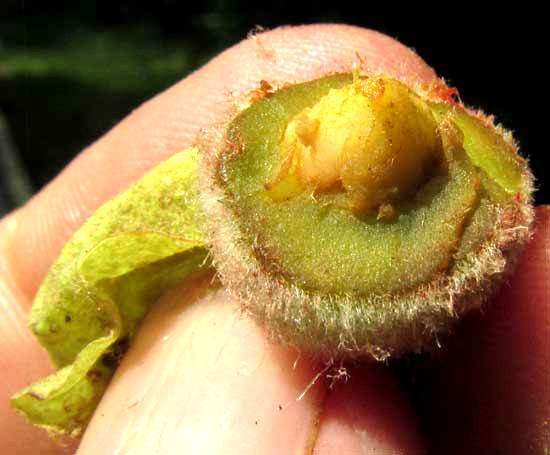
It looks like we may actually have two seeds there, but I couldn't pry them apart with my thumbnail.
So, these are interesting, sometimes unusual, details, but even still I couldn't even imagine which plant family the tree might belong to. It wasn't until I got onto the Internet and "did the botany" with some technical keys that the family affiliation revealed itself, and it was a shocker. This large tree, apparently being grown as a tropical hardwood for its wood, is a member of the Mint Family, the Lamiaceae.
What's so mind-boggling is that we all know that members of the Mint Family normally are small, pungent herbs, that a good field mark for the family is that its fruits usually break apart into four "nutlets," the inflorescences aren't so huge, and they don't bear one or a few fuzzy fruits inside papery bladders. At first glimpse, the only thing about this tree reminiscent of the Mint Family is its squared stems bearing opposite leaves. Whatever the case, realizing that we had a large, plantation tree that was a member of the Mint Family, it was easy to figure out the species.
This is TECTONA GRANDIS, the Teak tree, the same Teak people are talking about when referring to Teak plantations in southeastern Asia,.
Teak, which can grow to 30m high (98ft), is grown for its wood, which is described as particularly durable and water resistant. Often it's used for boat building, exterior construction, furniture, carving, furniture, and many other purposes. Teak wood is said to smell like leather when it's freshly milled. Behind both the wood's water resistance and odor are its natural oils, which also provide resistance to termites and other wood-destroying invertebrates, and fungal diseases.
The wood's high value has caused the same situation we see with Oil Palms: Throughout the world's tropics, much old-growth tropical forest has been cleared to make room for Teak. At least a fair part of the land where I saw Mexico's Teak plantations seems to have been ranchland earlier, so maybe the problem with clearing old-growth forest isn't as important here. In Equatorial Africa Teak was planted widely during the Colonial era, and now that valuable timber, along with oil reserves, are at the heart of the current South Sudanese conflict. Whenever large amounts of money are involved, it seems that there's trouble, even when it's over an interesting member of the Mint Family.
So, how can Tectona grandis be a member of the Mint Family? The bladder turns out to be the original flower's tiny calyx very much expanded. In the Mint Family's skullcaps, genus Scutellaria, the calyx develops a substantial crest-like projection on the back, and in the Shell-Flower, Molucella laevis, the "shell" part is the flower's much expanded, shell-like calyx, so there's no reason why Teak calyxes shouldn't enlarge to form bladders around their fruits. Also I read that the tiny flowers bear five or six stamens extending well beyond the corollas, which is mint-like. But, what about those four nutlets we expect Mint-Family fruits to divide into?
My old Bailey's Manual of Cultivated Plants doesn't seem to think that the Teak's single, fuzzy drupes qualify for the Mint Family, but nowadays experts appear to believe that they do. The Teak flowers' ovaries are four-celled, with one ovule in each cell, perfectly correct for the Mint Family, so I'm guessing that most ovules succumb to natural abortion, leading to what's seen in our pictures.
What a pleasure meeting this famous, nonconformist member of the Mint Family, and what a surprise to find it being planted in Mexico.